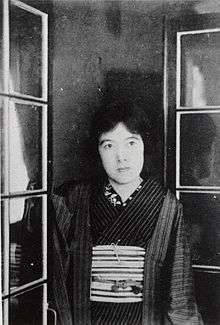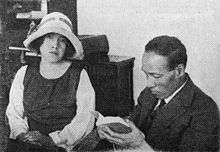Akiko Yosano
| Akiko Yosano | |
|---|---|
 | |
| Born |
7 December 1878 Sakai, Osaka, Japan |
| Died |
29 May 1942 (aged 63) Tokyo, Japan |
| Occupation | Writer, educator |
| Genre | poetry, essays |
| Notable works | Kimi Shinitamou koto nakare |
| Spouse | Tekkan Yosano |
Akiko Yosano (与謝野 晶子 Yosano Akiko, Seiji: 與謝野 晶子, 7 December 1878 – 29 May 1942) was the pen-name of a Japanese author, poet, pioneering feminist, pacifist, and social reformer, active in the late Meiji period as well as the Taishō and early Shōwa periods of Japan.[1] Her name at birth was Shō Hō (鳳 志よう Hō Shō).[2] She is one of the most famous, and most controversial, post-classical woman poets of Japan.[3]
Personal life
Yosano was born into a prosperous merchant family in Sakai, near Osaka. From the age of 11, she was the family member most responsible for running the family business, which produced and sold youkan, a type of confection. From early childhood, she was fond of reading literary works, and read widely in her father's extensive library. When she was a high school student, she began to subscribe to the poetry magazine Myōjō ("Bright Star"), and she became one of its most important contributors. Myōjō's editor, Tekkan Yosano, taught her tanka poetry. They met when he came to Osaka and Sakai to deliver lectures and teach workshops.[4]
Although Tekkan had a common-law wife, Tekkan and Akiko fell in love. Tekkan eventually separated from his common-law wife, and the two poets started a new life together in the suburb of Tokyo. Tekkan and Akiko married in 1901. The couple would have two sons, Hikaru and Shigeru. Despite separation from his first wife, Tekkan remained actively involved with her.
Yosano helped to found what was originally a girls' school, the Bunka Gakuin (Institute of Culture), together with Nishimura Isaku, Kawasaki Natsu and others, and became its first dean and chief lecturer.[5] She assisted many aspiring writers to gain a foothold into the literary world. She was a strong advocate of women's education all of her life. She also translated the Japanese classics into the modern Japanese language, including the Shinyaku Genji Monogatari ("Newly Translated Tale of Genji") and Shinyaku Eiga Monogatari ("Newly Translated Tale of Flowering Fortunes").[6]
She gave birth to 13 children, 11 of whom survived to adulthood. The Japanese politician Kaoru Yosano (Yosano Kaoru) is one of her grandsons.[7]
Yosano died of a stroke in 1942, at the age of 63.[8] As her death occurred in the middle of the Pacific War, it went largely unnoticed in the press, and after the end of the war, her works were largely forgotten by critics and the general public. However, in recent years, her romantic, sensual style has come back into popularity and she has an ever increasing following. Her grave is at Tama Cemetery in Fuchu, Tokyo.
Literary career
In 1901, Yosano brought out her first volume of tanka, Midaregami ("Tangled Hair"), which contained 400 poems and was mostly denounced by literary critics.[9] Despite the critical reaction, it was widely read and became a sort of lighthouse for free-thinkers of her time. Her first book, by far her best known, brought a passionate individualism to traditional tanka poetry, unlike any other work of the late Meiji period. She followed this with twenty more tanka anthologies over the course of her career, including Koigoromo ("Robe of Love") and Maihime ("Dancer"). Her husband Tekkan was also a poet, but his reputation was eclipsed by hers. He continued to publish his wife's work and to encourage her in her literary career. Yosano Akiko was an extraordinarily prolific writer. She could produce as many as 50 poems in one sitting. During the course of her lifetime, Yosano Akiko wrote tens of thousands of poems. The number is usually put at 20,000 to 50,000 poems. She also wrote 11 books of prose.

Yosano's poem Kimi Shinitamou koto nakare[10] (君死にたもうこと勿れ, Thou Shalt Not Die), addressed to her younger brother,[10] was published in Myōjō during the height of the Russo-Japanese War and was extremely controversial.[11] Made into a song, it was used as a mild form of anti-war protest,[10] as the number of Japanese casualties from the bloody Siege of Port Arthur became public.
During the Taishō period, Yosano turned her attention to social commentary, with Hito oyobi Onna to shite (As a Human and as a Woman), Gekido no Naka o Iku (Going through Turbulent Times) and her autobiography Akarumi e (To the Light). Her commentaries tended to criticize Japan's growing militarism, and also promoted her feminist viewpoints. Her final work, Shin Man'yōshū ("New Man'yōshū", 1937–1939) was a compilation of 26,783 poems by 6,675 contributors over a 60-year period.
Midaregami
Midaregami is Akiko Yosano’s first tanka (31 syllable poems, arranged in 5-7-5-7-7) collection, published in 1901, which consists of around 400 poems. The majority of the poems in this collection are love poems through which Akiko expresses her feelings towards Tekkan Yosano, her mentor and (later on) husband. It was through this particular collection that she set an image for herself as well as the stage for female voices in modern Japan. In these poems she displayed an affinity for expressing femininity in a manner that was not conventional for her time, especially from the work of a female writer.
From the eyes of traditional Japanese views women are seen as (and expected to be) gentle and modest. The domestic and societal roles of women were focused on procreation and raising children (particularly of boys). Midaregami not only expresses concepts and/or issues that pertain to women which are not normally voiced in such a public manner but it also created a new image of womanhood. The portrait of women that Akiko painted through her poems was revolutionary. She depicted women to be lively, free, sexual and assertive, nothing at all like the conventional picture.
These women were not passive and were active agents of their love lives. Midaregami, thus, posed a challenge to patriarchal society, as well as literary and cultural conventions, that Japan was already so accustomed to at the time. Although Akiko Yosano’s work was denounced and severely critiqued, it served as a great source of inspiration to women of the time.
As mentioned, these visual representations symbolize women’s sexuality. From these particular examples, the idea of nudity changed the way Japanese people viewed eroticism and female sexuality. Up until this point women’s breasts were a symbol for child feeding and motherhood. From then on they began to take on a different representation; that of natural beauty, of young women specifically. A door is opened for Japanese women to see new representations of sexuality and the female body.
See also
| Wikimedia Commons has media related to Akiko Yosano. |
References
- ↑ Beichman, Janine (2002-01-01). Embracing the Firebird: Yosano Akiko and the Birth of the Female Voice in Modern Japanese Poetry. University of Hawaii Press. ISBN 9780824823474.
- ↑ Henshall, Kenneth (2013-11-07). Historical Dictionary of Japan to 1945. Scarecrow Press. p. 481. ISBN 9780810878723.
- ↑ Akiko, Yosano (2014-01-07). River of Stars: Selected Poems of Yosano Akiko. Shambhala Publications. ISBN 9780834829336.
- ↑ Arana, R. Victoria (2015-04-22). Encyclopedia of World Poetry. Infobase Learning. ISBN 9781438140728.
- ↑ Rodd, Laurel Rasplica (1991-01-01). "Yosano Akiko and the Bunkagakuin: "Educating Free Individuals"". The Journal of the Association of Teachers of Japanese. 25 (1): 75–89. doi:10.2307/488911. JSTOR 488911.
- ↑ Emmerich, Michael (2013-08-13). The Tale of Genji: Translation, Canonization, and World Literature. Columbia University Press. ISBN 9780231534420.
- ↑ Arana, R. Victoria (2008-01-01). The Facts on File Companion to World Poetry: 1900 to the Present. Infobase Publishing. p. 484. ISBN 9781438108377.
- ↑ George Haggerty; Bonnie Zimmerman (2000). Encyclopedia of lesbian and gay histories and cultures. Taylor & Francis. p. 823. ISBN 978-0-8153-3354-8. Retrieved 29 December 2011.
- ↑ Yosano, Akiko (2002-01-01). Tangled Hair: Selected Tanka from Midaregami. Cheng & Tsui. ISBN 9780887273735.
- 1 2 3 J. Thomas Rimer; Van C. Gessel (2005). Modern Japanese literature. Columbia University Press. pp. 333–334. ISBN 978-0-231-11860-6. Retrieved 29 December 2011.
- ↑ James L. McClain, Japan: A Modern History p 427 ISBN 0-393-04156-5
External links
- Kamakura's Literary Figures
- e-texts of Akiko's works at Aozora Bunko
- Yosano Akiko and War – Torikai Lab (Archived 2009-10-24) (Japanese)